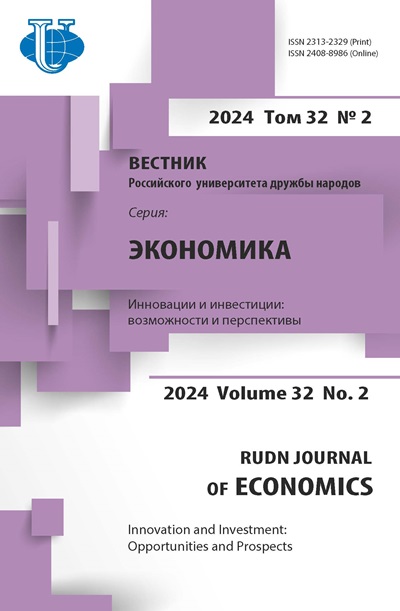Газовый сектор как фактор международной конкурентоспособности
- Авторы: Лавров С.Н.1, Симонов А.Г.2
-
Учреждения:
- ООО «Вестерн Петролеум Транспортэйшн»
- Российский университет дружбы народов
- Выпуск: Том 29, № 1 (2021)
- Страницы: 164-172
- Раздел: ЭКОНОМИКА ОТРАСЛЕВЫХ РЫНКОВ
- URL: https://journals.rudn.ru/economics/article/view/26022
- DOI: https://doi.org/10.22363/2313-2329-2021-29-1-164-172
Цитировать
Полный текст
Аннотация
Статья является первой из серии статей, посвященных проблеме комплексной экономической и геополитической конкуренции ведущих мировых держав в энергетическом секторе. Рассматриваются актуальные тенденции мировой экономики. Предпринята попытка системного анализа долгосрочных тенденций развития мировой энергетики на основе сравнения различных энергоносителей и сопоставления капитальных затрат сооружения электрогенерирующих мощностей на их основе. В этом контексте производится причинно-следственное сопоставление трансформации международных производственно-сбытовых цепочек и энергетического обеспечения экономики, с одной стороны, и революционных изменений международных экономических отношений, вызванных санкционным противостоянием по линиям США - Китай и Россия - ЕС, США, с другой. Делается вывод о первостепенном значении развитой газовой промышленности для повышения глобального энергетического лидерства мировых держав в средне- и долгосрочной перспективе. Представлен анализ дальнейшего развития европейского газового рынка, в рамках которого рассматриваются наиболее эффективные варианты действий российского государства.
Об авторах
Сергей Николаевич Лавров
ООО «Вестерн Петролеум Транспортэйшн»
Автор, ответственный за переписку.
Email: lavrovsn@mail.ru
доктор экономических наук, профессор, советник-консультант
Российская Федерация, 121069, Москва, Скатертный пер., д. 5AАлександр Геннадьевич Симонов
Российский университет дружбы народов
Email: simonov-ag@rudn.ru
кандидат экономических наук, доцент кафедры международных экономических отношений
Российская Федерация, 117198, Москва, ул. Миклухо-Маклая, д. 6Список литературы
- Al-Mohannadi, D.M., et al. (2017, December). On the synthesis of carbon constrained natural gas monetization networks. Journal of Cleaner Production, 168, 735-745. doi: 10.1016/j.jclepro.2017.09.012.
- Andronova, I.V., & Kolbikova, E.S. (2016). Russian natural gas reforms and trends on the domestic and export markets. RUDN Journal of Economics, (4), 31-38.
- Carr, M. (2019, August 8). U.S. sanction plan for Russian pipe could repeat Reagan failures. Bloomberg. Retrieved November 15, 2020, from www.bloomberg.com/news/articles/2019-08-08/u-s-sanction-plan-for-russian-pipe-could-repeat-reagan-failures
- Komlev S. (2016). Gazprom on European market: Challenges and solutions. ETCSEE2016 (15-16 June, Bucharest, Romania). Retrieved October 15, 2020, from http://www.gazpromexport.com/files/2016_06_10_ETCSEE_Komlev236.pdf
- Konoplyanik, A.A. (2019). O novoj paradigme razvitiya mirovoj energetiki, riskah i vyzovah dlya Rossii i mira [About the new paradigm of development of global energy, risks and challenges for Russia and the world]. Moscow, The Institute of Economic Forecasting of the Russian Academy of Sciences.
- Konovalova, Yu.A., & Ushanov, S.A. (2019). EU in the system of trade interests of USA. RUDN Journal of Economics, 27(2), 386-400. http://dx.doi.org/10.22363/2313-2329-2019-27-2-386-400
- Larionova, M.V. (2016). Evaluating global institutions’ effectiveness. International Organisations Research Journal, 11(1), 126-152.
- Lazard. (2020). Levelized cost of energy and levelized cost of storage - 2020. Retrieved October 15, 2020, from www.lazard.com/perspective/levelized-cost-of-energy-and-levelized-cost-of-storage-2020/
- Reed, S. 6 June 2020. OPEC and Russia agree to extend oil production cuts. The New York Times. Retrieved October 15, 2020, from www.nytimes.com/2020/06/06/business/energy-environment/opec-russia-oil-coronavirus.html
- Sánchez Nicolás, E. Why is EU off track for 2020 energy efficiency target? EUobserver. Retrieved October 15, 2020, from euobserver.com/energy/147407
- Streimikiene, D., et al. (2020, June 1). Climate change mitigation in households between market failures and psychological barriers. Energies, 13(11), 2797. doi: 10.3390/en13112797.
- Tréanton, K. (2008). International workshop on energy statistics units of measurement and conversion, prices and emissions section. UN Statistical Department. Retrieved October 15, 2020, from https://unstats.un.org/unsd/energy/meetings/mexico2008/Presentations/Session%206%20-%20Introduction.pdf
- U.S. Energy Information Administration. (2020). Cost and performance characteristics of new generating technologies. Annual Energy Outlook 2019. Retrieved October 15, 2020, from https://www.eia.gov/outlooks/aeo/assumptions/pdf/table_8.2.pdf
- U.S. Energy Information Administration. (2020). Cost and performance characteristics of new generating technologies: Annual energy outlook 2019. Retrieved October 15, 2020, from https://www.eia.gov/outlooks/aeo/assumptions/pdf/table_8.2.pdf















